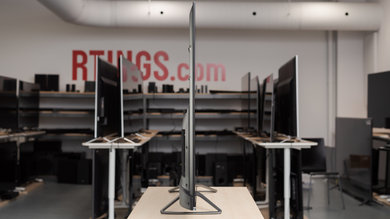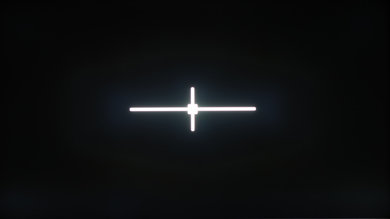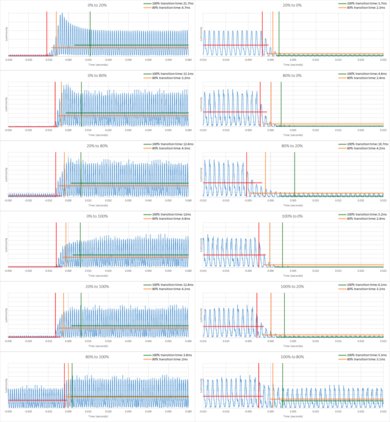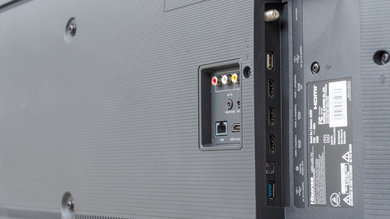Our Verdict
The Hisense H9F is a great TV for almost any use. It has great motion handling and low input lag, great for gaming or for use as a PC monitor. This TV has excellent peak brightness and great reflection handling, so glare shouldn't be an issue in a bright room. Unfortunately, there are some noticeable uniformity issues, and the image degrades at an angle, which isn't great for watching sports.
- Excellent peak brightness.
- Deep blacks.
- Outstanding low input lag and an excellent response time.
- Some noticeable uniformity issues.
This is a great TV for watching movies in a dark room. It has an outstanding contrast ratio, and decent local dimming feature. Black uniformity is only decent, though, and there can be noticeable blooming in some scenes. It can play 24p content completely judder-free.
The H9F is a great TV for watching shows during the day. It has great reflection handling and excellent SDR peak brightness, so glare shouldn't be an issue, but the image degrades at an angle, so it isn't great if you like to move around. It has great smart features, and a huge selection of streaming apps.
Overall, the H9F is a good TV for watching sports in a bright room. It has a fast response time, so there is little blur behind fast-moving objects. It has excellent SDR peak brightness and great reflection handling, so glare shouldn't be much of an issue. Unfortunately, there is some noticeable dirty screen effect, and the image degrades at an angle, so it isn't the best for watching sports with a group of friends.
This is an excellent TV for playing video games. It has outstanding low input lag, for a responsive gaming experience, and an excellent response time, so there is very little blur behind fast-moving objects. It also has excellent contrast, great for late-night gaming. Unfortunately, despite the 120Hz panel, this TV doesn't accept 1080p @ 120Hz or 1440p @ 120Hz signals, and it doesn't support any advanced gaming features, like FreeSync variable refresh rate technology.
This is a great TV for watching movies in HDR. It has excellent contrast, a decent local dimming feature, and great HDR peak brightness. It has only decent black uniformity, though, and blooming can be an issue in dark scenes. It can has a great wide color gamut, and it can play 24p content without judder.
The H9F is an excellent TV for HDR gaming. It has outstanding low input lag in HDR and an outstanding response time, so there is very little blur behind fast-moving objects. The contrast ratio is excellent, and it can display a wide color gamut. Unfortunately, it doesn't support any advanced gaming features, like FreeSync variable refresh rate technology.
This is an excellent TV for use as a PC monitor. It has outstanding low input lag, for a responsive experience, and it has an excellent response time, so there is very little blur. It can display chroma 4:4:4 and RGB signals properly, so text looks clear.
Changelog
- Updated Sep 14, 2020: Fixed an error with color gamut photo.
- Updated May 21, 2020: Converted to Test Bench 1.5.
- Updated Feb 21, 2020: Converted to Test Bench 1.4.
- Updated Aug 09, 2019: Review published.
Check Price
Differences Between Sizes And Variants
We tested the 65" H9F (65H9F), and we expect our results to also be valid for the 55" (55H9F) model.
If someone comes across a different type of panel or if their Hisense H9F doesn't correspond to our review, let us know and we will update the review. Note that some tests such as the gray uniformity may vary between individual units.
In Canada, the H9F is known as the Q9809, but we expect it to perform the same.
| Size | US Model | Canada | Panel Type | Refresh Rate | Dimming Zones |
| 55" | 55H9F | 55Q9809 | VA | 120Hz | 100 |
| 65" | 65H9F | 65Q9809 | VA | 120Hz | 132 |
The 65H9F we reviewed was manufactured in April 2019.
Popular TV Comparisons

The Hisense H9F delivers great performance at a budget-friendly price, and outperforms many pricier models. See our recommendations for the best smart TVs, the best LED TVs, and the best budget TVs.
The Hisense H9F is a bit better than the Vizio M Series Quantum 2019 for most uses. The H9F is a lot brighter, and it has a faster response time, which is great for gaming. The H9F can also interpolate motion up to 120Hz, whereas the M Series Quantum 2019 has no motion interpolation feature. The M Series Quantum 2019, on the other hand, has much better black uniformity and a more versatile black frame insertion feature, making it a slightly better choice for a completely dark room.
The Vizio P Series Quantum 2019 and the Hisense H9F are very similarly performing TVs. While the Vizio has a better local dimming feature and better black uniformity, the Hisense has better contrast. The Hisense can also get quite a bit brighter, has better motion handling, and uses Android TV for its smart interface which is smoother and has access to many more apps than Vizio's SmartCast. On the other hand, the Vizio has better gray uniformity, a wider color gamut, and better built-in speakers.
For the most part, the Hisense H9F is better than the Hisense H8F. The H9F has a much better response time, resulting in much clearer motion with 60Hz content. This is especially important for gaming. The H9F is also much brighter, and small highlights in HDR appear much closer to the content creator's intent. On the other hand, the H8F has much better black uniformity, and there is less blooming around bright objects in dark scenes.
The Sony X900F and the Hisense H9F have very similar performance. The Sony can handle the reflections of a brighter room better. The Hisense H9F, on the other hand, has a lower input lag which will please gamers and those who plan to use the TV as a PC monitor.

We buy and test dozens of TVs yearly, taking an objective, data-driven approach to deliver results you can trust. Our testing process is complex, with hundreds of individual tests that take over a week to complete. Most of our tests are done with specially designed test patterns that mimic real content, but we also use the same sources you have at home to ensure our results match the real-world experience. We use two main tools for our testing: a Colorimetry Research CR-100 colorimeter and a CR-250 spectroradiometer.
Test Results

The Hisense H9F is the highest-end model from Hisense for 2019. It doesn't directly replace any previous Hisense model, as Hisense is advertising it as part of their new "ULED" product line, similar to the "QLED" branding used by Samsung. The H9F mainly competes with similar budget models, including the TCL 6 Series/R617 2018, Vizio M Series Quantum 2019, and the Samsung RU8000.
Overall, the Hisense H9F has a good design. It has decent build quality; although it's mostly made of plastic, there are a few more metallic components than the H8F. The stand has a very unique design, and it supports the TV well, with only a bit of wobble. The overall design is fairly basic, and there is no cable management.
The back of the TV is plain. The top half is made of a thin metal sheet, and the bottom half that houses the electronics is made of plastic.
There is no cable management.
The borders on this TV are extremely thin. Like some LG TVs, including the SM9000, the bezel doesn't completely protect the panel, as the panel itself sits on top of the frame.
The Hisense H9F has outstanding contrast, very similar to the H8F. The local dimming feature boosts the contrast even higher, resulting in one of the highest contrast ratios we've seen on any recent TV, similar to the Vizio P Series Quantum 2019.
For the most part, the local dimming feature looks great. It has good blooming control around larger bright objects. Unfortunately, like the H8F, it can't keep up with some fast zone changes, causing the leading edge to appear darker.
The local dimming feature doesn't handle small bright objects very well, and there is significant blooming around them. In this sample photo, some blooming can be seen, and it looks worse in person.
This TV has excellent SDR peak brightness. There is some variation in brightness with different content, which isn't ideal, but this shouldn't cause any issues. This TV is significantly brighter than the Vizio M Series Quantum 2019, but isn't quite as bright as the TCL 6 Series/R617 2018.
We measured the SDR peak brightness after calibration, with the 'Theater Dark' Picture Mode, Backlight level set to 'Max', and Local Dimming on 'High'. Different picture modes deliver different results, but these settings deliver the most accurate results, and the highest peak brightness, which is uncommon.
This TV has great peak brightness in HDR, but it isn't quite as bright as the TCL 6 Series/R617. There is some variation in brightness with different content (also known as ABL), and large bright scenes aren't as bright as small highlights. Small specular highlights in some scenes really stand out.
We tested the HDR peak brightness with no calibration settings, with the HDR Theater 'Picture Mode', the backlight at maximum, and local dimming on 'High'. Different settings may result in a lower peak brightness, as these settings are the most accurate, and the brightest.
Like most TVs with VA panels, the image on the H9F degrades when viewed at an angle. With this TV, the image appears washed out when viewed even slightly off-angle, as the black levels rise very quickly. At wider angles, colors lose accuracy and appear washed out as well. If viewing angles are important, an OLED TV like the LG C9, or an LED TV with an IPS panel like the LG SM9000 are better choices.
The Hisense 65H9F has great reflection handling overall, but some really bright light sources might be distracting in some cases. This TV has much better reflection handling than the new TCL R625.
With our pre-calibration settings, the H9F has decent accuracy. Gamma is high, and appears to target 2.4 instead of our 2.2 target. There are some noticeable inaccuracies in most colors, as well as in most shades of gray. The color temperature is a bit warm.
After calibration, most of the issues are corrected. White balance is almost perfect, but pure white is still inaccurate. There are still some noticeable color errors as well, but most people won't notice any issues. The color temperature is extremely close to the target of 6500K.
See our recommended settings here.
Update 09/14/2020: Fixed an error in the way the color gamut photo was displayed. It did not change the results.
This TV has a great color gamut, and it can display a wide color gamut. Unfortunately, in the 'HDR Theater' Picture Mode, the EOTF doesn't follow the PQ curve at all. In dark scenes, blacks are crushed, and appear darker than they should. In slightly brighter scenes the image is brighter than should be.
In 'Game' mode, the EOTF follows the PQ curve more accurately, but most scenes are still too bright. Game mode is also noticeably darker than the other picture modes, reaching an absolute peak of 621 cd/m², which is unexpected.
If you find HDR too dark, setting Adv. Contrast Enhancer to 'Medium' results in a noticeably brighter image, as shown in this EOTF.
Good color volume. It's limited by the TV's color gamut, and it can't produce colors as bright as pure white, especially blues, which is normal for LED TVs. It displays dark saturated colors well, thanks to the excellent contrast ratio.
Overall, this TV has good gradient performance. There is some noticeable banding, and it's slightly more noticeable in shades of red, gray, and green. Unfortunately, there is no smooth gradation feature on this TV.
There are no signs of temporary image retention, even immediately after displaying the high-contrast static test image for 10 minutes.
We don't expect VA panels to experience permanent image retention, as the VA panel in our long-term test appears immune.
The H9F has an excellent response time. There is significant overshoot in some transitions, though, which may be especially noticeable in really dark scenes. These results are much better than the H8F, and result in much clearer motion, with very little blur behind fast-moving objects. There are some noticeable duplications, though, due to the flicker of the TV's backlight.
The H9F has a much faster response time than the TCL R625.
The H9F, like the H8F, always flickers at 960Hz. This high-frequency flicker shouldn't bother most people, but it causes noticeable duplications in motion. Although the H9F has the same flicker frequency as the TCL R625, the duplications aren't as noticeable on the H9F.
The Hisense H9F has an optional black frame insertion feature that can slightly improve the appearance of motion, by reducing the flicker frequency to 120Hz. Unfortunately, when playing at 60Hz, it can only flicker at 120Hz, so there are still noticeable duplications. This is unexpected, as the H8F can flicker at 60Hz with 60Hz content.
The H9F has a brightness compensation system, so unlike most TVs, enabling the black frame insertion feature doesn't significantly dim the screen, unless you are close to the TV's maximum brightness.
This feature can be enabled by enabling the Motion Clearness setting, under the 'Advanced Settings' menu.
The H9F has a 120Hz panel, and it can interpolate lower frame rate content up to 120 frames per second (FPS). In more demanding scenes, there can be noticeable artifacts or dropped frames.
During testing, we encountered a bug with the settings, where adjusting either the 'Judder Reduction' or 'Blur Reduction' slider would deactivate the other setting.
Due to the excellent response time of this TV, there's some noticeable stutter when watching movies, or other low frame rate content. When watching movies, this is especially noticeable with slow panning shots. If this bothers you, the motion interpolation feature can help reduce the amount of stutter.
The Hisense H9F can remove judder from any source. For 24p sources, like Blu-ray players, or for 60Hz interlaced sources, no settings are required; they are always played judder-free. For 60p sources, the Motion Enhancement setting has to be set to 'Film' for judder-free playback.
This TV has a native 120Hz panel, but it doesn't support any variable refresh rate technologies, like FreeSync.
The Hisense 65H9F has outstanding low input lag with any input signal, as long as 'Game' mode is used. Unfortunately, it doesn't support auto low latency mode, so to get the lowest input lag, you have to manually enable 'Game' mode when you start playing.
Update 08/16/2019: We rechecked the H9F, and it is possible to send a 120Hz signal, but it simply skips every other frame. We confirmed this from an Xbox One S and a PC.
This TV supports most of the common input formats, but only at 60Hz. Despite the 120Hz panel, it can't display any 120Hz signal. All supported formats can also display chroma 4:4:4 properly, but only in 'Game' mode.
4k @ 60Hz signals with RGB, or chroma 4:4:4 or 4:2:2, only work if the HDMI 2.0 format setting is set to 'Enhanced'.
The H9F supports HDR10 and Dolby Vision from the native apps as well as external devices. Some older Dolby Vision devices might require a firmware update.
This TV can pass Dolby Digital and DTS signals through both HDMI-ARC, and an optical cable connection. It doesn't support eARC, though.
This TV has a disappointing frequency response, similar to the H8F. The low-frequency extension (LFE) is bad, and the bass has no thump or rumble, very little body, and almost no punch. The frequency response above the LFE is fairly flat, so dialog is clear for the most part, but it lacks airiness due to the drop-off in the low to mid treble range. This TV can get decently loud, with very few compression artifacts, but it might not be loud enough for loud environments. If you want a similar TV with better built-in speakers, look into the Hisense H8G.
Decent distortion handling. At lower volume levels, the total distortion is very low. At maximum volume, the total amount of harmonic distortion increases significantly, but it's still decent.
Like other TVs running Android TV 8.0, the interface is well-organized and easy to use. Like the H8F and recent Sony TVs, it's easy to get to the content you want.
Like the H8F, this TV is completely ad-free. This may change though, as ads were introduced on Sony TVs running Android Oreo 8.0. There is a row of suggested content, but this can be disabled completely. If you see ads on your H9F, let us know in the discussions down below, and we'll update our review.
Update 11/26/2019: YouTube now supports HDR on the H9F.
Like all TVs running Android TV, the H9F has a massive selection of apps available, and most of the common streaming services are pre-installed.
This TV can also interact with Amazon Alexa devices, and it supports Google Assistant, although we don't currently test these features.
The remote is identical to the one found on the H8F, and is very comfortable and easy to use. It has a good selection of buttons, including dedicated app buttons for some of the most popular streaming services. It also supports voice control.
















































